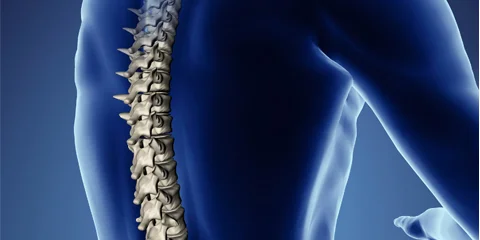Scoliosis is a pathological deformity of the spine in all three directions of space that occurs during rapid growth.
Spinal curvature (Scoliosis)

Types of Scoliosis
The most prevalent (80%) is the so-called idiopathic scoliosis. Its cause is unknown. Generally manifests itself during the growth spurt years, ages 7-9 or 12-15. The side to side curvature of the spine is accompanied by the rotation of the vertebrae around the axis leading to the development of a hump at the dorsal spine segment and an anterior protrusion alongside the lumbar spine. Rarer is the congenital scoliosis caused by improper development of the vertebra and the vertebral arch.
Others: curvature may develop as a consequence of conditions such as neurofibromatosis and Scheuermann's disease that cause the vertebrae to loose their firmness. Loss of muscle strength may also lead to deformities since muscles not doing their job in supporting the spine, will cause the curvature.
Symptoms, Complications
In all types of scoliosis, it is true that, unless the deterioration of the curvature stops, severe deformity will result, decreasing the respiratory surface of the lung, making blood circulation in the lungs more difficult and, thereby, causing the work of the heart to be much more difficult. Damage to the lung is followed then by cardiac insufficiency. The Patient eventually becomes unable to bear any weight and loses the capacity to work. In addition, the degenerations of the spine causing the pain speed up and severe cosmetic changes develop.
Treatments
Foremost in spinal deformities is early detection. In very mild cases, no therapy may even be necessary. In more pronounced cases, conservative treatment (physiotherapy, corset) may be required. If conservative treatment was not possible due to the advanced maturity of the bone structure, or, did not prevent further progression and it became evident that the Patient's condition.
Indications for Surgery
Adolescent scoliosis
Dorsal curvature:
• reaches, or exceeds 50 degrees
• the 40-50 degree curvature shows definite progression
Lumbar curvature:
• reaches, or exceeds 45 degrees
• the 35-45 degree curvature shows definite progression
Adult cases
• the intense pain resulting from the deformity was not alleviated in spite of conservative treatment
• curvature is greater than 50 degrees and continual progression confirmed
The description was prepared with the cooperation of the spine surgeons of the Buda Health Center.
Feel free to contact our specialists!
At the Buda Health Center, you have the opportunity to attend the private practices of more than 300 renowned specialists, offering expertise in nearly 45 medical specialisms, at five locations. Personalized care is provided by a well-trained and empathetic staff of professionals, who have been working together for a long time. Based on our 23 years of experience and the feedback received from our 450,000 clients, we are constantly working to organize our healthcare services in the most efficient way possible for those who visit us, paying respect to their needs and time.

